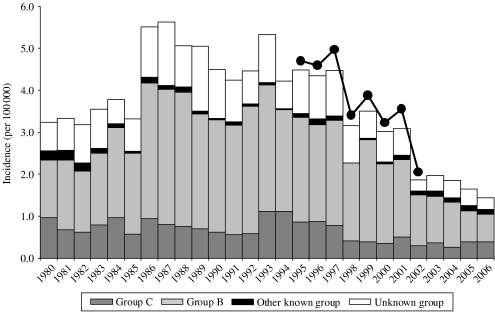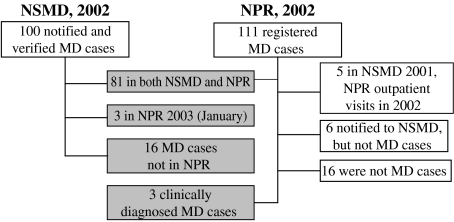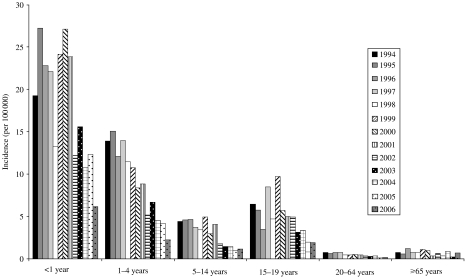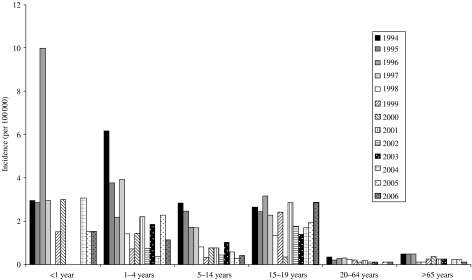SUMMARY
Denmark has in the past 10 years experienced a decrease in the number of notified cases of meningococcal disease. In 1994 the completeness of the Notification System for Meningococcal Disease (NSMD) was estimated as 96% (95% CI 93–98). To answer the question whether the observed decrease reflects a real decrease in the incidence; we estimated the completeness of the notification system in 2002. We estimated the completeness of registration by a capture–recapture analysis. As the first data source, we used the national NSMD, which is an integrated surveillance system between the Department of Epidemiology and the Neisseria Reference Laboratory. The second independent source was the National Patient Registry (NPR). In 2002, the completeness of the NSMD was estimated as 96% (95% CI 95–98) and for the NPR as 84% (95% CI 82–85). The ‘real’ incidence rate was 1·9/100 000 population, which compared to 4·4/100 000 population in 1994. We concluded that the observed decrease in incidence rate is real. The NSMD in Denmark functions well and captures almost all cases of meningococcal disease. The complete registration which includes a unique personal identification number serves as an outstanding source for nationwide registry linkage studies.
INTRODUCTION
The annual number of notified cases of meningococcal disease (MD) in Denmark has gradually decreased in the last 10 years (Fig. 1). Several European countries have registered less MD cases in recent years [1]. In Iceland, Ireland, Belgium, The Netherlands and the United Kingdom part of the explanation can be attributed to successful implementation of the conjugate vaccine targeted at serogroup C MD in the respective childhood vaccination programmes [1]. Denmark has not introduced this vaccine in the childhood vaccination programme, since the incidence of MD due to serogroup C has remained low.
Fig. 1.
The incidence of meningococcal disease (MD) and the serogroup-specific incidence from the notification system for meningococcal disease (NSMD), 1980–2006, and the incidence of registered cases in the National Patient Registry (NPR) with ICD-10 code A39, 1995–2002 (–•–). (The MD incidence rate from the NPR is based on notified cases and has not been scrutinized to verify the diagnoses, as was done for years 1994 and 2002.)
Denmark has experienced outbreaks with both serogroups B and C. In 1986–1987 and 1987–1989 phenotype B:15:P1.7,16 was responsible for major regional outbreaks and has been the predominant phenotype in Denmark in the 1980s and 1990s [2, 3]. This phenotype was introduced in Denmark in 1976 and is the same phenotype which caused a prolonged outbreak in Norway in the 1970s and 1980s [4]. The second most common phenotype in the 1980s and 1990s in Denmark was C:2a:P1.2,5, which caused major outbreaks in 1983–1984, 1986 and 1989 [3, 5].
The completeness of the surveillance system for MD in Denmark is believed to be very high. A close collaboration and exchange of information between the Neisseria Reference Laboratory and the Department of Epidemiology ensures a high coverage of disease notifications for laboratory-confirmed cases. In 1994 an evaluation of the Notification System for Meningococcal Disease (NSMD) revealed the completeness as 96% [95% confidence interval (CI) 93–98], using the National Patient Registry (NPR) as a second ‘independent’ source in a capture–recapture analysis [6].
In the present study our objective was to validate the NSMD in Denmark for 2002, applying the same method and registries used in 1994. With two point estimates of the completeness of notifications, we can assess whether the observed decrease in incidence of MD in the recent decade is real or falsely driven by a decreasing sensitivity of the notification system. Furthermore, we discuss actions taken to prevent MD in Denmark in the previous decade.
MATERIAL AND METHODS
To estimate the ascertainment of MD several methods have been used, e.g. a simple comparison of data sources, capture–recapture methods, retrospective review, prospective follow-up and regression methods [7]. These methods can give an estimate of the completeness of reporting. However, to extend the information obtained it is important to be aware of the case definition used and how consistent the reporting to the source(s) is over time. In the present study we used NSMD, which is part of the national surveillance system for communicable diseases, and NPR as independent sources to estimate the completeness of each registry. In addition, we calculated the ‘real’ incidence of MD for 2002 using the capture–recapture method.
Case definition
In the study we adopted the European Centre for Disease Prevention and Controls (ECDC) case definition for 2006, which correspond to the case definition in the Danish NSMD:
a clinically compatible case diagnosed by isolation or detection of the Neisseria meningitidis bacteria, nucleic acid, antigen and/or antibody specific to N. meningitidis, or
a clinically compatible case with demonstration of Gram-negative diplococci from a normal sterile site by microscopy, or
a clinically compatible case without laboratory confirmation.
To qualify as a case patients must have fallen ill in Denmark or been transferred to Denmark while ill and admitted to hospital.
Notification System for Meningococcal Disease (NSMD)
Since 1 January 1980 it has been mandatory to report by phone all verified and clinically suspected cases of MD to the Regional Medical Officer of Health and afterwards by a standardized notification form both to the Regional Medical Officer of Health and the Department of Epidemiology at Statens Serum Institut. In 1992 NSMD was enhanced, by referring information on positive N. meningitidis samples from the Neisseria Reference Laboratory, also at Statens Serum Institut, to the Department of Epidemiology. If not already notified, a reminder is mailed to the treating doctor/department. All notifications received are carefully judged by an epidemiologist and further information is requested if it is not clear whether the case fulfils the case definition. For a notification to be excluded agreement is required from two epidemiologists.
The National Patient Registry (NPR)
Since 1 January 1977 all hospital admittances, and since 1 January 1995 all outpatient visits has been recorded in the NPR. The ICD-10 system was implemented in Denmark in 1994 and is still in use. For every hospital discharge the treating physician signs a discharge letter with one or several ICD-10 codes specifying the diagnosis. We requested information on all cases with ICD-10 diagnosis of A39 for the years 2001–2003. Included in ICD-10 code A39 are: A39.0, meningococcal meningitis; A39.1, Waterhouse–Friederichsen syndrome; A39.2, acute meningococcaemia; A39.3, chronic meningococcaemia; A39.4, meningococcaemia unspecified; A39.5, meningococcal heart disease; A39.8 other meningococcal infections and A39.9, meningococcal infection, unspecified.
Hospital records and laboratory results on cases with an ICD-10 code A39, which did not match a case in NSMD were requested and a decision was made by two epidemiologists whether the case fulfilled the case definition or not. In the case of disagreement, a third person was asked.
Capture–recapture analysis
The method was originally invented by biologists to estimate the size of a closed animal population; by capturing and tagging animals and later recapturing animals and counting how many had been captured before [8]. The same principle has been used in epidemiology to estimate the quantity of specific conditions based on two or more data sources [9]. The assumptions we make are considered in the Discussion.
RESULTS
In 2002, 100 cases were notified to NSMD and 111 persons were registered with a discharge ICD-10 code A39 in NPR (Fig. 2). A total of 81 cases matched on identification numbers between the two registries in 2002; in addition three were registered with onset of MD in 2002 in NSMD, but admitted to hospital in January 2003 and therefore registered in NPR 2003 records. These three cases matched between the registries and were included, leaving a total of 84 matched cases in the two registries. The Department of Epidemiology had to send a reminder for a written notification to the clinical departments for 37% of cases with a positive N. meningitidis laboratory result in 2002.
Fig. 2.
Flow diagram of notified cases to the Notification System for Meningococcal Disease (NSMD) and the National Patient Registry (NPR), 2002. MD, Meningococcal disease.
Of the remaining 30 cases in NPR in 2002 six were registered with a discharge MD diagnosis and notified to NSMD but did not fulfil the case definition. Five cases had onset of disease in 2001 and were excluded from the analysis. For the last 19 cases, we received a discharge letter. Three of these cases fulfilled the case definition, 16 did not (Fig. 2). Based on MD discharge diagnoses, the over-reporting in 2002 to NPR was 26% [(6+16)/(81+3)].
Initially 116 cases were notified to NSMD with onset of disease in 2002. Of these, 16 did not fulfil the case definition and were excluded from NSMD. This gives an over-notification in 2002 of 16% (16/100).
Table 1 shows the number of MD cases in each registry. The estimated ‘true’ total number is 104 MD cases (95% CI upper limit 106) for 2002. The completeness of NSMD was estimated as 96% (95% CI 95–98) and of NPR as 84% (95% CI 82–85). The ‘real’ overall incidence of MD in Denmark in 2002 was estimated to 1·9/100 000 inhabitants compared with 1·8/100 000 as stated in the epidemiological report for 2002 [10].
Table 1.
Number of cases fulfilling the case definition for meningococcal disease according to source of registration, 2002
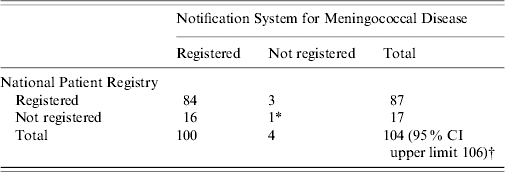
Calculated: x=n – 84–3 – 16.
Calculated: n=(100×87)/84; 95% CI=n±1·96×(100×87×16×3/843)½.
In the 16 cases notified to NSMD, but not registered in NPR, we retrieved the ICD-10 action diagnosis registered on the discharge letters. It is noteworthy that three patients had ICD-10 code A39 stated on the discharge letter, A39.2A (two cases) and A390.0, but were not captured in NPR. The code M01.0 meningococcal arthritis was unfortunately not retrieved when data where extracted from NPR (one case). The remaining 12 ICD-10 diagnoses were: G00.9 bacterial meningitis, unspecified (four cases), A41.9 septicaemia, unspecified, R57.8A endotoxic shock, J18.9 pneumonia, unspecified, J80.9 adult respiratory distress syndrome, J44.9 chronic obstructive pulmonary disease, unspecified, D69.0 allergic purpura, D69.0B Henoch–Schönlein purpura and R96.0 instantaneous death.
Stratified analysis
Table 2 presents a stratified analysis by age, region, vital status and confirmation method. The completeness was generally high for NSMD in all subgroups, except three clinical cases which were not captured in NSMD. For NPR the capture rate is low for Funen county and fatal MD cases. All fatal cases were admitted to hospital. NSMD is superior to NPR in all subgroups, except for clinical cases, for which an under-notification was observed.
Table 2.
Stratified analysis for meningococcal disease cases by age, region, vital status and confirmation method in the Notification System for Meningococcal Disease (NSMD) and the National Patient Registry (NPR), 2002
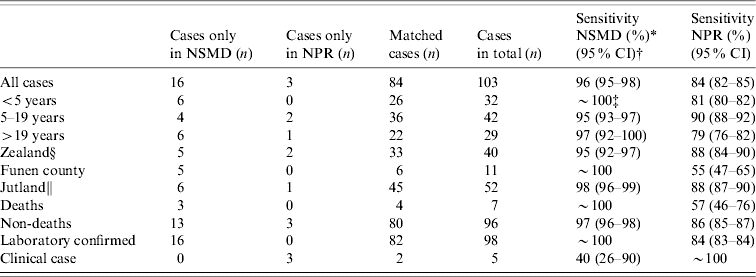
NSMD, Notification System for Meningococcal Disease; NPR, National Patient Registry.
(Cases only in NSMD+Matched cases)/(Cases only in NSMD+Cases only in NPR+Matched cases). (Note: In all cases; 104 cases were used as the denominator.)
95% CI=Sensitivity±1·96 Var(sensitivity); Var(sensitivity)=(Cases only in NSMD+Matched cases)×(Cases only in NPR+Matched cases)×(Cases only in NSMD)×(Cases only in NPR)/(Matched cases)3.
~100=All, except the single case estimated in the capture–recapture analysis caught by none of the data sources, were captured.
Zealand: Copenhagen and Frederiksberg Municipality and Copenhagen, Frederiksborg, Roskilde, West Zealand, Storstrøm and Bornholm counties.
Jutland: South Jutland, Ribe, Vejle, Ringkøbing, Aarhus, Viborg and North Jutland counties.
Age- and serogroup distribution
The overall incidence rate peaked in 1987. In the period 1994–2002 both NSMD and NPR observed a decrease in the incidence of MD (Fig. 1). Serogroup B has been the predominant serogroup throughout the period, followed by serogroup C. In absolute incidence rate serogroup B cases declined from 1999, while serogroup C cases have remained stable since 1998 (Fig. 1). In relative numbers the proportion of serogroup B cases peaked in 1999 with 69%, but has since decreased to 46% in 2006, while serogroup C cases have increased from 11% to 27% in that period.
The youngest age group (<1 year) and teenagers (15–19 years) experienced an increase or steady incidence rate for serogroup B from 1994 to 1999, followed by a decrease, while the other age groups experienced a fall or remained at a low incidence rate throughout the period 1994–2006 (Fig. 3).
Fig. 3.
Notification System for Meningococcal Disease: age-specific incidence rate of serogroup B meningococcal disease in Denmark, 1994–2006.
For serogroup C it appears that teenagers (age 15–19 years) remain at an age-specific incidence rate around 2 cases/100 000 population, while a decrease in the period under study have been observed in other age groups (Fig. 4).
Fig. 4.
Notification System for Meningococcal Disease: age-specific incidence rate of serogroup C meningococcal disease in Denmark, 1994–2006.
DISCUSSION
The current surveillance system for MD, NSMD, had a high completeness of notifications in 2002, 96% (95% CI 95–98). The high coverage is comparable to the completeness in 1994, which confirms the assumption that the decrease in incidence of MD in Denmark is real. In both 1994 and 2002 NSMD had a higher completeness of notifications than NPR, reflecting that NSMD is an active surveillance system and NPR is a passive registry.
Trotter et al. have reviewed published and unpublished reports on ascertainment of MD in European countries since 1969 and found a completeness of notifications within the respective national surveillance systems from 40% to 96%. Sweden and Austria likewise had a completeness of MD notifications exceeding 80% [7].
In the stratified analysis we found a lower sensitivity in NPR for MD cases in the Funen region, the numbers are small and we are unaware of any differential misclassification which could explain the lower sensitivity. Similarly, NPR has a low sensitivity for fatal cases, which is explained by the fact that N. meningitidis is not always isolated at the time of completing the discharge letter.
The three cases not captured at NPR had the discharge diagnoses: J44.9 chronic obstructive pulmonary disease, unspecified; R57.8A endotoxic shock and G00.9 bacterial meningitis, unspecified.
Capture–recapture assumptions
The use of the capture–recapture method is based on four assumptions: (1) a closed population, (2) only cases fulfilling the case definition are counted and they are uniquely identifiable between sources, (3) each case has the same chance of being captured in each source, and (4) the two sources are independent of each other.
We will consider each of these assumptions below.
The risk of somebody becoming infected in Denmark and falling ill with MD outside the country is remote, since MD is a relatively uncommon disease with a short incubation period, and most MD cases arise 3–5 days after infection [11–13]. The population was not closed in a strict sense, but we consider the risk of including or missing cases infected in the country to balance throughout a year. Hence, three tourists were hospitalized with MD and included in the analysis, but we do not consider this a problem.
Maintaining a standardized case definition for the two registries, as ECDCs, limits the risk of differential misclassification, and makes the incidence rate obtained comparable to other countries with the same case definition. Cases are uniquely matched by the personal identification number assigned to all Danes or persons registered with an address in Denmark since 1968 [14].
Both registers are well implemented in the Danish health system. The severity of MD leads to hospitalization, and all patients in the analysis were hospitalized and assigned an ICD-10 code.
The two registries used in the analysis are maintained at two different institutions. A notification to NSMD does not trigger a registration in NPR, or vice versa. However, it is more likely that a laboratory-confirmed case of MD is registered in NSMD, due to the share of information at Statens Serum Institut, than a purely clinical case, which is more likely to be registered only in NPR (Table 2). Regal & Hook state the following: ‘Any two sources are independent if the overall, i.e. average, probability of members of a population who appear in their intersection or “overlap” is equal to the product of the average probabilities of appearing in A, and in B’ [9, 15]. Following this statement, the sources used in the analysis are independent sources (100/104×87/104=0·804; 84/104=0·808) (Table 1).
In a recent comparison of aetiologies of bacterial meningitis in Denmark obtained from the regional clinical microbiological departments and the notification system for bacterial meningitis at The Department of Epidemiology, Statens Serum Institut, the capture rate of meningococcal meningitis cases at the Department of Epidemiology were estimated as 97% for 2002 and 100% for 2003 [15].
Thoughts on the decrease in the MD incidence rate
Our results illustrate that the incidence rate of MD has decreased from 4·4/100 000 population in 1994 to 1·9/100 000 population in 2002 and continued to decreas in recent years (Fig. 1).
Denmark has not implemented any meningococcal vaccines in routine vaccination programmes. The number of meningococcal vaccines sold in Denmark has remained constant in the last decade, covering less than 1% of the population per year with the polysaccharide vaccine.
Chemoprophylaxis has been recommended for household contacts of a MD case in Denmark since 1978 [16]. Overall, the recommendation has been followed, and in the period 1980–1996, only 2% of notified cases have been registered as secondary cases [6]. In 1992, the recommendation for chemoprophylaxis for household contacts was changed from rifampicin to ciprofloxacin as first choice drug, since ciprofloxacin has a higher elimination rate of N. meningitidis among carriers. Furthermore, from 1992 the same persons who were receiving chemoprophylaxis were recommended vaccination, if the index case was infected by a vaccine-preventable serogroup. Before 1992, vaccination was only recommended in relation to clusters of at least two cases, if a vaccine-preventable serogroup. Apart from this shift, we have no indication on larger changes in the prophylaxis measures for secondary cases during the period 1994–2006.
The presence of MD strains fluctuates over time, but the phenotype B:15:P1.7,16 which was introduced in 1976 in Denmark, still represented 56% (72/128) of all serogroup B strains in 1999. Among serogroup C cases serotype 2a predominated at least from 1987, but a shift to more serotype 2b and serotype 15 in 1998 has been observed [4, 17].
We conclude that the decrease in the MD incidence rate in Denmark is real. Since we find no obvious explanation for the decrease, we find that the decrease is likely to be explained by natural fluctuation of MD. As a hypothesis, it might be interesting to explore whether factors such as an increase in antimicrobial drug usage in general, or the general decrease in tobacco use are prompting temporal changes in MD incidence.
ACKNOWLEDGEMENTS
We thank The Neisseria Reference Laboratory at Statens Serum Institut and Lene Berthelsen for efficiency in retrieving meningococcal samples from the regional clinical microbiology departments throughout the period under study. We also thank Annette Hartvig Christiansen for epidemiological follow-up on MD cases in 2002 and the scrutinizing of unclear cases considered for this capture–recapture analysis.
DECLARATION OF INTEREST
None.
REFERENCES
- 1.Health Protection Agency, London . Invasive Neisseria meningitidis in Europe 2003/2004. (http://www.euibis.org/documents/20032004_meningo.pdf). Accessed 28 August 2007.
- 2.Samuelsson S et al. An outbreak of serogroup B:15:P1.16 meningococcal disease, Frederiksborg County, Denmark, 1987–9. Epidemiology and Infection. 1992;108:19–30. doi: 10.1017/s0950268800049463. [DOI] [PMC free article] [PubMed] [Google Scholar]
- 3.Weis N, Lind I. Usefulness of the DNA-fingerprinting pattern and the multilocus enzyme electrophoresis profile in the assessment of outbreaks of meningococcal disease. Epidemiology and Infection. 1996;116:103–114. doi: 10.1017/s0950268800052328. [DOI] [PMC free article] [PubMed] [Google Scholar]
- 4.Poolman JT et al. Meningococcal serotypes and serogroup B disease in north-west Europe. Lancet. 1986;2:555–558. doi: 10.1016/s0140-6736(86)90123-6. [DOI] [PubMed] [Google Scholar]
- 5.Ronne T et al. Comparative studies on pharyngeal carriage of Neisseria meningitidis during a localized outbreak of serogroup C meningococcal disease. Scandinavian Journal of Infectious Diseases. 1993;25:331–339. doi: 10.3109/00365549309008507. [DOI] [PubMed] [Google Scholar]
- 6.Samuelsson S. Surveillance and prevention of meningococcal disease Denmark 1980–1996 (Ph.D. thesis). Faculty of Health Sciences, University of Southern Denmark, Odense, Denmark: 1999 [Google Scholar]
- 7.Trotter C et al. Ascertainment of meningococcal disease in Europe. Eurosurveillance. 2005;10:247–250. [PubMed] [Google Scholar]
- 8.Petersen CGJ 1896. pp. 6–48. . The yearly immigration of young plaice into the Limfjord from the German sea. Report, Danish Biological Station. , pp.
- 9.Hook EB, Regal RR. Capture-recapture methods in epidemiology: methods and limitations. Epidemiological Reviews. 1995;17:243–264. doi: 10.1093/oxfordjournals.epirev.a036192. [DOI] [PubMed] [Google Scholar]
- 10.Christiansen AH, Samuelsson S 2002. http://www.ssi.dk/graphics/en/news/epinews/2003/pdf/2003_16_17.pdf. http://www.ssi.dk/graphics/en/news/epinews/2003/pdf/2003_16_17.pdf . Meningococcal Disease . . Department of Epidemiology, Statens Serum Institut ( ). Accessed 28 August 2007.
- 11.Boutet R et al. Risk of laboratory-acquired meningococcal disease. Journal of Hospital Infections. 2001;49:282–284. doi: 10.1053/jhin.2001.1084. [DOI] [PubMed] [Google Scholar]
- 12.Edwards EA et al. Immunological investigations of meningococcal disease. III. Brevity of group C acquisition prior to disease occurrence. Scandinavian Journal of Infectious Diseases. 1977;9:105–110. doi: 10.3109/inf.1977.9.issue-2.09. [DOI] [PubMed] [Google Scholar]
- 13.Orr H et al. Cluster of meningococcal disease in rugby match spectators. Communicable Disease and Public Health. 2001;4:316–318. [PubMed] [Google Scholar]
- 14.Pedersen CB et al. The Danish Civil Registration System. A cohort of eight million persons. Danish Medical Bulletin. 2006;53:441–449. [PubMed] [Google Scholar]
- 15.Meyer CN et al. Bacterial meningitis in Denmark 2002–2003. A nation-wide laboratory-based registration [in Danish] Ugeskrift Læger. 2007;169:503–506. [PubMed] [Google Scholar]
- 16.National Board of Health National Board of Health; 1978. . Notice to Health Officers regarding chemoprophylaxis and vaccination in case of meningococcal disease. Circular 4102-4-1978, [Google Scholar]
- 17.Lind I, Berthelsen L. Epidemiology of meningococcal disease in Denmark 1974–1999: contribution of the laboratory surveillance system. Epidemiology and Infection. 2005;133:205–215. doi: 10.1017/s0950268804003413. [DOI] [PMC free article] [PubMed] [Google Scholar]



